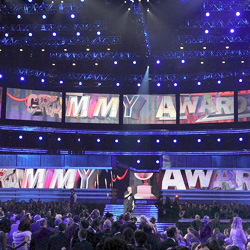
Prep Pays Off
From the centrally located mix position on the main floor of the Staples Center, Reaves mixes every musical performance, one right after the other.
Stewart handles all other house mixing duties, and this year, he also did a masterful job with a performance featuring Norah Jones joined by John Mayer and Keith Urban on acoustic guitar gathered around a single Shoeps microphone for a wonderful rendition of Dolly Parton’s classic “Joleen.”
This marks the ninth year that Reaves has provided the live music mix for the show, following a long stint as a touring engineer (primarily doing monitors) with Showco, as well as some work with TASCO and as an independent.
In the early 1990s, he began transitioning to TV/entertainment mixing, encouraged by Pat Baltzell and Bruce Burns, with Stewart also supporting his work and eventually bringing him over to provide the house mix for the Grammys.
His preparation process begins five days before the show, when audio coordinator Michael Abbott provides a detailed information set for the entire show in spreadsheet form.
This includes settings for every artist to be set up as snapshots in the console, as well as input lists, configuration of the system, and whole host of other details.
Armed with this information, his entire first day is spent programming every snapshot over the course of a 12-plus hour day. (It’s the same story for the other live mixers on the gig.)
“My goal is to have the show ‘pre-dialed up’ in the PM1D, so to speak – snapshots and inputs entered, and then put where I need them,” he explains. “I also set up channel libraries – kick drums, snare drums, overheads, whatever – that are pre-EQ’d and pre-bused.
The goal is to be able to instantaneously raise the appropriate fader when its needed and go. You have to be pretty fast on the show, and the only way to guarantee that is preparation.”
His board takes 56 inputs from stage A, another 56 from stage B, and then there’s another 56 with all vocals as well as sources from the production trucks. While the 170 or so inputs aren’t usually in use at the same time, they need to be constantly managed.
“As complex as this show has gotten because of the technology, the reason we can pull it off, and at a high level, is because we’re on digital desks,” he says.
“When you’re talking about some of the performances, such as three to four acts in a single medley, or two full bands with Bob Dylan, it would be almost impossible to do it on analog boards. Plus, there’s not enough real estate available even if you wanted to try it.”
The first big day of programming and preparation is followed by four days of rehearsals with every act on the bill, with dress rehearsal the last day.
These 14-hour sessions include discussions with representatives for every artist, listening to their wishes and requests and then doing everything possible within the confines of the production to make them happen.
